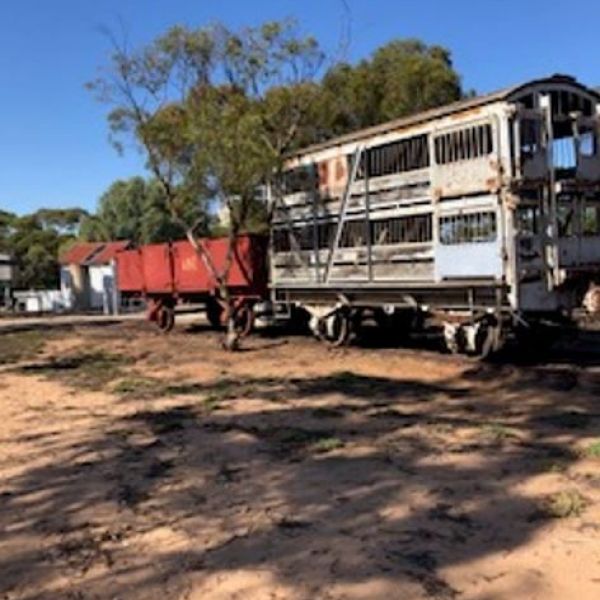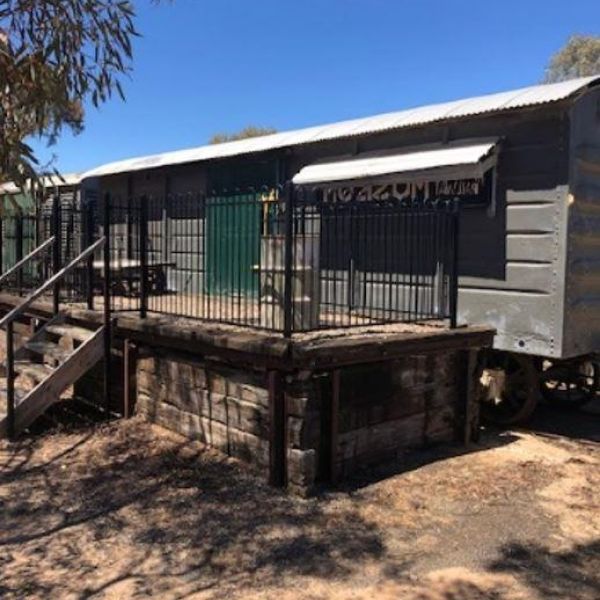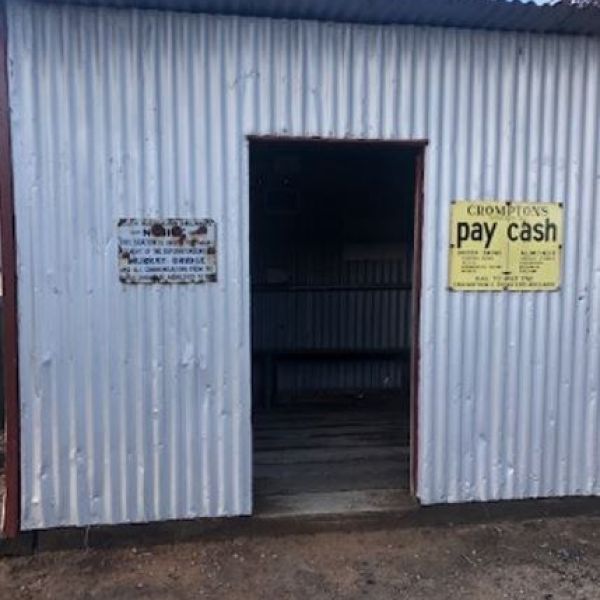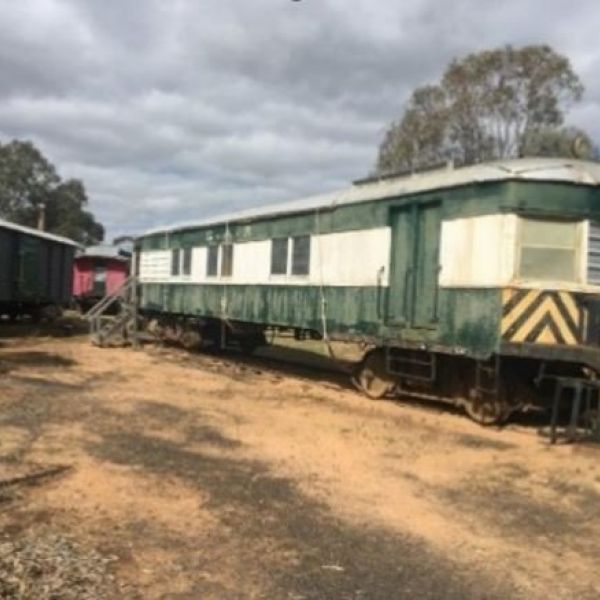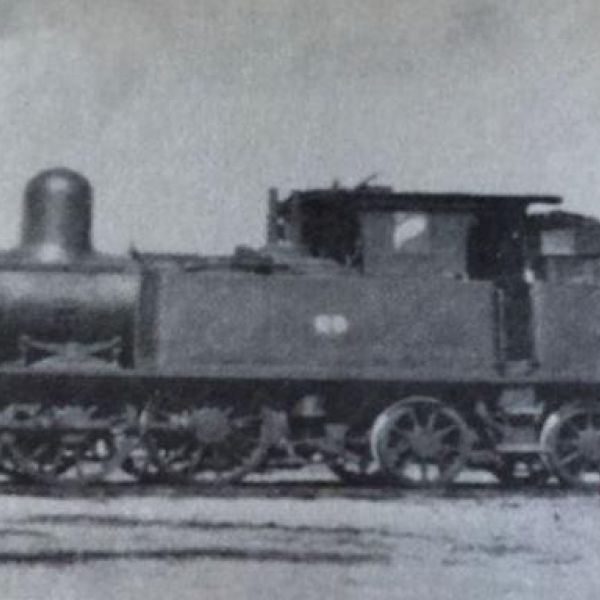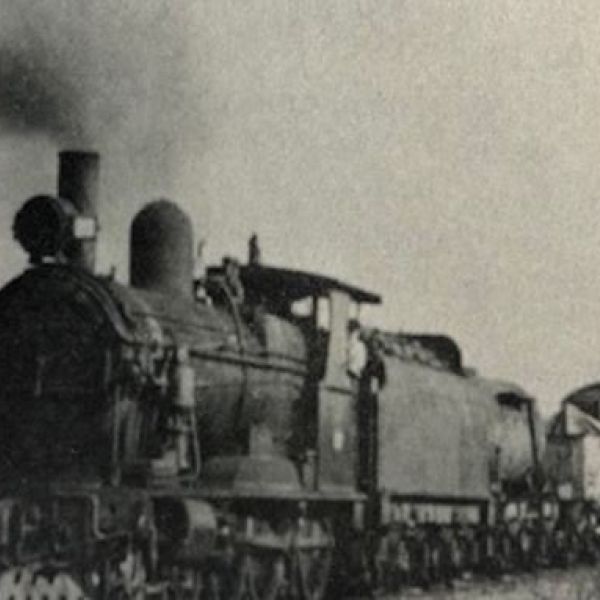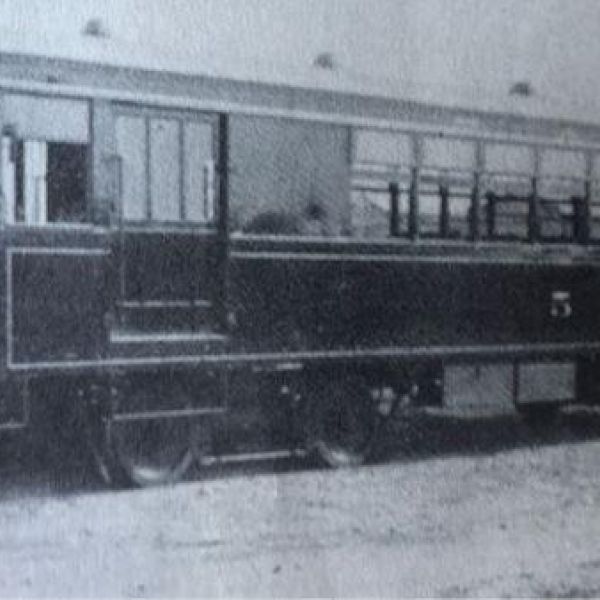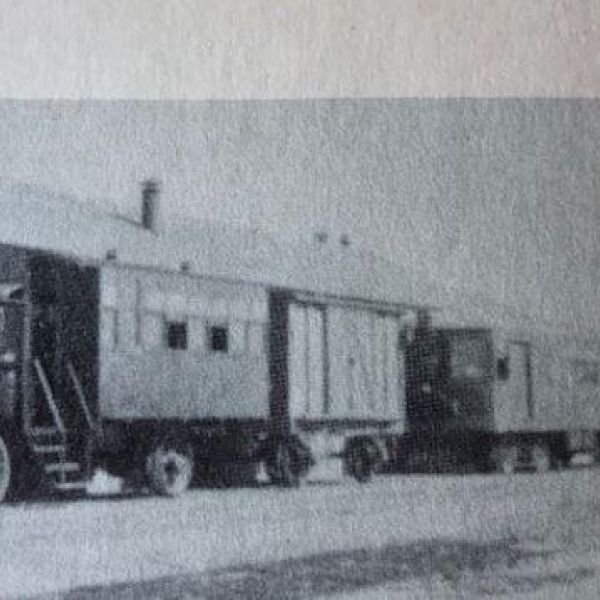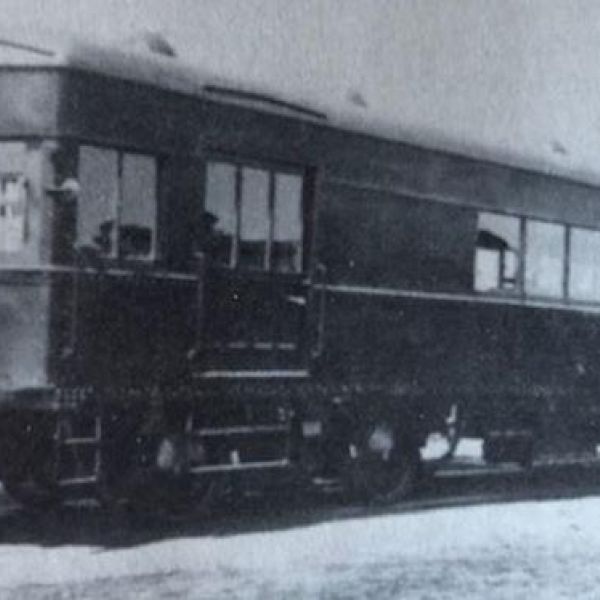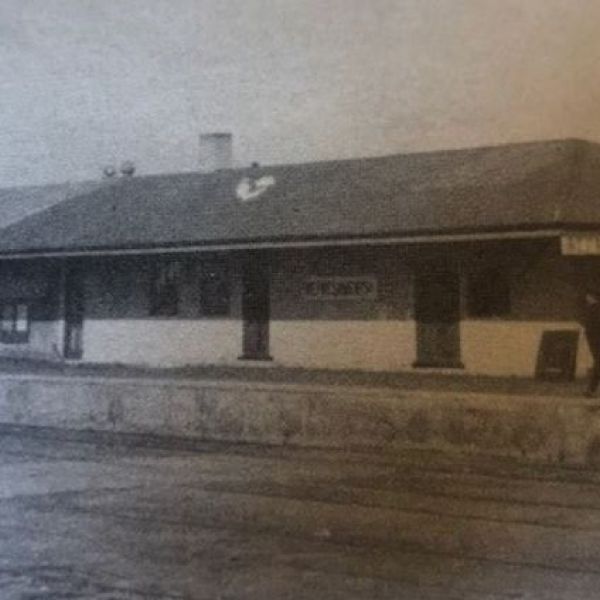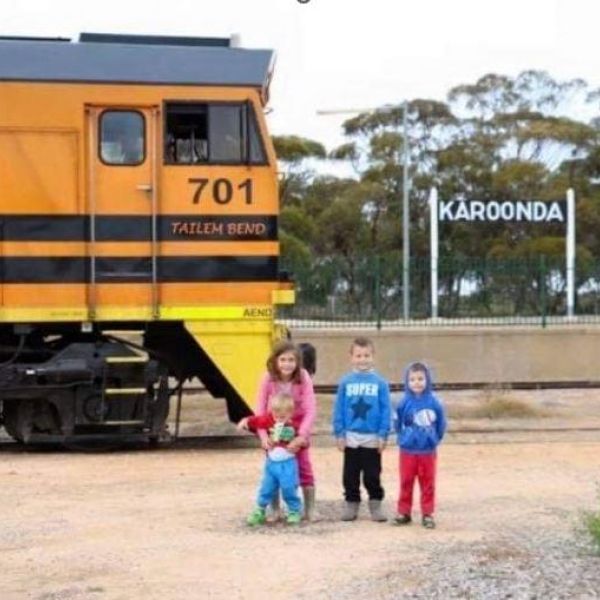Railway Carriages in Pioneer Park
Sheep Van
This half size van was used to transport sheep in and out of the district. Sheep vans came in full size and half size versions and was almost the only way that farmers could bring sheep in and out of the area. When a farmer ordered a livestock van to send livestock away, the van was shunted to the loading ramp at the stock yards and the farmer had to do his/her own loading. The guard checked the door fastenings and then shunted the van onto the train. Incoming vans of livestock were shunted to the stockyard, lined up with the loading ramp and left for the consignee to unload.
Half Size Open Truck
These also came in half and full-sized trucks and were covered with a tarpaulin when carrying superphosphate. The trucks were used to carry mallee stumps and sawn mallee back to Adelaide. Some farmers made more money out of stumps than they did out of grain.
More information about the firewood can be read on p 547 of ‘Karoonda East Murray A History to 1986’ Alan Jones
Ventilated Half Goods Truck and Full-Length Goods Truck
Goods Shed
Farmers left their cream cans and egg crates in the shed and filled out a consignment form which they placed in a box. Because it was a single-track, trains would come up one day and back the next. At some of the bigger sidings like Wynarka the goods shed and another bigger shed were up on the platform.
Until the 1940’s most farmers kept cows and ran fowls. Both were valuable sidelines bringing in extra money for families. The milk was separated and the cream put in cans for sale to butter manufacturers. Cream cans and egg crates were a major part of the loading picked up by the mixed trains and the rail cars. In the 1950’s during the wool boom some farmers gave up the labour-intensive sidelines and this source of freight dropped.
Diesel Railcar
These are commonly known as Barwell Bulls or Brill cars and were used on Mallee lines from around 1930 -1940. This carriage ended its service as a sleeping van for railway gangers and was brought across to Pioneer Park in 1986.
Red Carriage
This passenger carriage ended service as a kitchen and dining car for remote rail gangers.
Rail Services
When the Brown’s Well line opened trains ran each way daily. The service was reduced in 1913 and then increased to daily again. Trains began running on the branch lines and ran from Adelaide on Mondays, Wednesdays and Fridays and returned on Tuesdays, Thursdays and Saturdays. Freight for the Mallee lines came to Tailem Bend in general freight trains and the trucks containing the Mallee line goods were remarshalled at Tailem Bend for the Paringa line. Passengers also were transferred to the passenger coaches on the mixed trains. There was much shunting and remarshalling at Karoonda as the wagons were detached from the Paringa line and attached to the Waikerie and Peebinga train. Passengers changed trains as well and whilst this was going on would have their lunch at the refreshment rooms run by Mr Hugh Hart.
The first 12 years the train from Tailem Bend was hauled by the Rx, K or Q class engine. All of these locomotives could run on light railways built with 41 pound rails. The Rx locomotive was fitted with the larger boiler and could haul up to 500 tons of freight and was the main work horse on the Mallee lines. Some S class locomotives were used to haul passenger trains; Tx and 78T locomotives were also used, with the latter being converted from narrow gauge to broad gauge in 1923. When large amounts of freight had to be hauled the railways sent out larger locomotives on the Paringa line but they were too heavy for the track and after several derailments and damage to the track they were withdrawn.
The mixed trains carried parcels and general freight including bread and meat from Karoonda. As all the stations were unmanned crew had to do all the loading and unloading and shunting of trucks on and off the train. The main items off loaded from the railcars were mail, parcels, empty cream cans and egg crates, hardware, corn, wool bales, fruit and vegetables, bread, skins and wool. Trucks that were shunted off from the freight trains carried superphosphate, fencing materials, windmills, bore pipes, fuel and building materials for wheat stacks and dunnage. Trucks picked up were usually loaded with wheat and firewood. Vans of livestock were picked up and dropped off as required.
Many people were employed in the maintenance gangs which were based at 11 mile (17.7kms) intervals along the track. Cottages were built for gangers and married packers, and barracks for single men.
The light construction of the Paringa line limited the amount of freight that could be carried and the speed at which the trains travelled which was causing significant economic loss. In 1923 the decision was made to relay the track from Tailem Bend to Karoonda with ballasted 60 pound rails and upgrade the gradient to 1:80. This was followed by an upgrade of the track through to Paringa in 1924 with the heavier rails which allowed heavier trains to travel on the line.
Around 1921 the South Australian railways began investigating the use of light motorised vehicles on lines with fewer passengers and less freight. The petrol engine chassis and engine manufactured by the Saurer Company was purchased in 1922. This was essentially a motor wheeled chassis equipped with rail bogies, fitted with a body that could seat 35 passengers and was used to operate the weekly train from Karoonda to Peebinga until it was scrapped in 1934.
This was followed by the American model 55 railcar introduced by JG Brill Company. Several of these began operating on the Mallee lines and seated 44 passengers and a larger baggage compartment. Travel time was reduced as there were no goods wagons to shunt off and could also run on the 41 pound lines. Once all of the railcars started operating the steam operated passenger trains only ran to Karoonda and passengers transferred to the railcars. For a time, a workshop for maintenance of these was based at Karoonda.
Model 75 railcars were introduced in 1927 that could seat 61 passengers and could haul trailers or wagons if needed. A diesel engine was installed in one of the railcars in 1934 on a trial basis, giving the cars more speed and used less fuel. Diesel engines were installed in more cars in 1937 and in the remainder by 1950. During the railcar era (1924-1940) specials were run to football matches and returning late at night after the tea and dance.
In 1940 mixed trains replaced the railcars on the Waikerie and Peebinga runs which brought an end to railcars in the Mallee. The railcars and and personnel were withdrawn from Karoonda and the shed demolished. Except for the Friday trolley to Peebinga, steam trains ran on all lines in the Karoonda system from 1940 until diesels came in in the 1960’s. Steam-hauled mixed trains ran on the Waikerie line three times a week and a mixed train ran to Peebinga and a motor trolley did a return trip on Friday.
Karoonda was a busy station in the 1920’s and 1930’s including crews for the mixed trains or railcars, up to ten porters and staff in the refreshment rooms. The District Foreman had his office at Karoonda. All items picked up by the railcars had to be transferred to the main line trains for onforwarding: cream, eggs, parcels, cases of fruit and even dogs in cages.
Diesel locomotives began hauling passenger and goods trains in the 1950’s and replaced steam locomotives over 20 years. The steam locomotives were gradually scrapped if beyond repair or transferred to other routes. The Mallee lines were some of the last to be operated by steam.
Diesel-hauled mixed trains continued until 1973 and then passenger services were discontinued. There were no passenger bus services through Karoonda and all livestock was carried by road transport. Australian National Railways made Loxton the regional freight centre. At this stage only local freight, superphosphate and grain, and through freight to Loxton passed through Karoonda. By 1986 Karoonda was the only manned station in the Council area with two employees and some track maintenance workers.
Australian National Railways (ANR) was established in 1975 by the amalgamation of the Commonwealth Railways, South Australian country railways and the Tasmanian Railways. The focus was on long distance high volume general freight and bulk commodities like grain and minerals. The era of government-funded railways operating at a loss to provide services to the community was over. By the end of 1995 the line from Alawoona through Renmark to Barmera had been closed and removed. Only the main line from Tailem Bend through Karoonda and Alawoona to Loxton remained.
The line from Tailem Bend was isolated after the Adelaide to Melbourne line was converted from broad gauge to standard gauge late in 1995. Work on standardising the Tailem Bend to Loxton began in March 1996 and on September 9, 1996 the first standard gauge trains began running to Loxton.
In 1987 ANR and the SACBH (South Australian Cooperative Bulk Handling Ltd) negotiated an agreement for a new method of transporting wheat and barley. A block train fitted with 40 discharge hopper wagons replaced individual wagons that were previously dropped off at silos and later picked up. Usually, these wagons were half filled at Tookayerta (near Loxton) and the remainder at Karoonda.
The Federal government owners of the ANR sold the South Australian intra-state operations (non-metropolitan) to the American firm of Genesee and Wyoming which began trading as Australian Southern Railroad. Following the dissolution of a joint venture with Wesfarmers operating railways in both South Australia and Western Australia, Genesee and Wyoming began trading as Genesee and Wyoming Australia as of June1, 2006.
Karoonda station closed on October 31, 1987. Frequent freight trains through Karoonda continued until 1991 and only grain specials ran by early in 1992. The last train ran to Karoonda on 8th July 2015.

